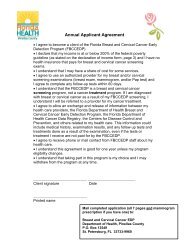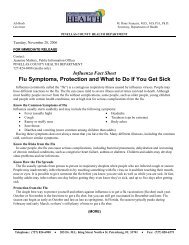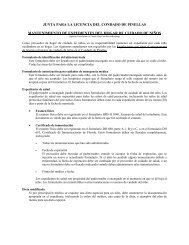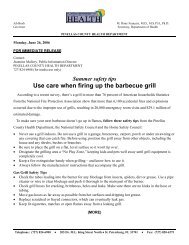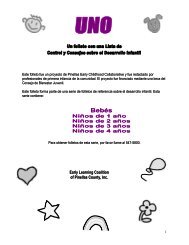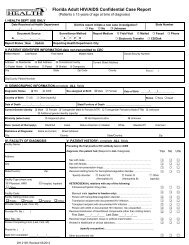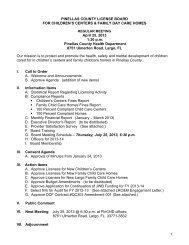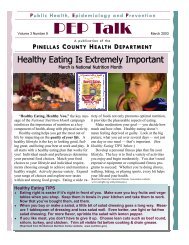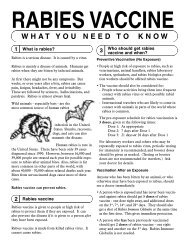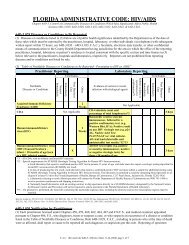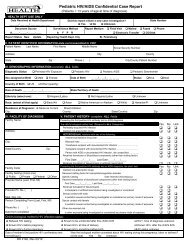Head Lice - Pinellas County Health Department
Head Lice - Pinellas County Health Department
Head Lice - Pinellas County Health Department
Create successful ePaper yourself
Turn your PDF publications into a flip-book with our unique Google optimized e-Paper software.
Jeb Bush<br />
Governor<br />
M. Rony François, M.D., M.S.P.H., Ph.D.<br />
Secretary, <strong>Department</strong> of <strong>Health</strong><br />
PINELLAS COUNTY HEALTH DEPARTMENT<br />
Wednesday, October 11, 2006<br />
FOR IMMEDIATE RELEASE<br />
Contact:<br />
Jeannine Mallory, Public Information Officer<br />
PINELLAS COUNTY HEALTH DEPARTMENT<br />
727-824-6908 (media only)<br />
<strong>Head</strong> <strong>Lice</strong>: <strong>Head</strong>y, nit-picky and lousy bugs<br />
For parents, a call from school announcing that their child has an infestation of the six-legged insects known as head<br />
lice is one of the most mortifying experiences imaginable.<br />
Many people look at head lice as a sign of a dirty home – an incorrect assumption. And parents – especially mothers –<br />
may feel a sense of shame that somehow they've failed their child – another wrong assumption. This shame is<br />
unnecessary because head lice are a fact of life and are not the sign of a dirty home or a neglectful parent.<br />
The good news is that there are steps parents can take to lessen the chances their child will be exposed to the bugs. The<br />
first step is to learn about head lice. Once parents know what they're looking for, they can keep a close eye on their<br />
children. They should watch for symptoms of head lice and examine their child's scalp regularly for nits or lice.<br />
Contact with a person already infested is the most common way to get head lice, and head-to-head contact is frequent<br />
during play at school and home. Prevention primarily involves making sure your child doesn't share anything that<br />
touches their hair with another child. Make sure kids don't share combs, brushes, caps or other things they put on their<br />
heads. If they sleep away from home, send their own pillow and towel.<br />
What are head lice?<br />
Also called Pediculus humanus capitis (peh-DICK-you-lus HUE-man-us CAP-ih-TUS), head lice are parasitic insects<br />
found on the heads of people. Having head lice is very common. However, there are no reliable data on how many<br />
people get head lice in the U.S. each year.<br />
Who is at risk for getting head lice?<br />
Anyone who comes in close contact (especially head-to-head contact) with someone who already has head lice is at<br />
greatest risk. Occasionally, head lice may be acquired from contact with clothing (such as hats, scarves, coats) or other<br />
personal items (such as brushes or towels) that belong to an infested person.<br />
Preschool and elementary-age children (3-11) and their families are infested most often. Girls get head lice more<br />
often than boys, women more than men. In the U.S., African-Americans rarely get head lice. Personal hygiene or<br />
cleanliness in the home or school has nothing to do with getting head lice.<br />
What do head lice look like?<br />
There are three forms of lice: the egg (also called a nit), the nymph and the adult.<br />
• Egg/Nit: Nits are head lice eggs. They are very small, about the size of a knot in thread, hard to see and are often<br />
confused for dandruff or hair spray droplets. Nits are laid by the adult female at the base of the hair shaft nearest<br />
the scalp. They are firmly attached to the hair shaft. They are oval and usually yellow to white. Nits take about one<br />
week to hatch. Eggs that are likely to hatch are usually located within 1/4 inch of the scalp.<br />
HEAD LICE – Page 2<br />
(MORE)<br />
Telephone: (727) 824-6900 • 205 Dr. M.L. King Street North • St. Petersburg, FL 33701 • Fax: (727) 820-4275
Jeb Bush<br />
Governor<br />
M. Rony François, M.D., M.S.P.H., Ph.D.<br />
Secretary, <strong>Department</strong> of <strong>Health</strong><br />
PINELLAS COUNTY HEALTH DEPARTMENT<br />
• Nymph: The nit hatches into a baby louse called a nymph. It looks like an adult head louse, but is smaller.<br />
Nymphs mature into adults about seven days after hatching. To live, the nymph must feed on blood.<br />
• Adult: The adult louse is about the size of a sesame seed, has six legs and is tan to greyish-white. In persons with<br />
dark hair, the adult louse will look darker. Females, which are usually larger than the males, lay eggs. Adult lice<br />
can live up to 30 days on a person's head. To live, adult lice need to feed on blood. If the louse falls off a person, it<br />
dies within two days.<br />
Where are head lice most commonly found?<br />
They are most commonly found on the scalp, behind the ears and near the neckline at the back of the neck. <strong>Head</strong> lice<br />
hold on to hair with hook-like claws found at the end of each of their six legs. <strong>Head</strong> lice are rarely found on the body,<br />
eyelashes or eyebrows.<br />
What are the signs and symptoms of head lice infestation?<br />
• Tickling feeling of something moving in the hair.<br />
• Itching, caused by an allergic reaction to the bites.<br />
• Irritability.<br />
• Sores on the head caused by scratching. These sores can sometimes become infected.<br />
How did my child get head lice?<br />
• Contact with an already infested person is the most common way to get head lice. <strong>Head</strong>-to-head contact is<br />
common during play at school and at home (sports activities, on a playground, slumber parties, at camp, etc.).<br />
• Less commonly, Wearing clothing (hats, scarves, coats, sports uniforms, hair ribbons, etc.) recently worn by an<br />
infested person.<br />
• Using infested combs, brushes or towels.<br />
• Lying on a bed, couch, pillow, carpet or stuffed animal that has recently been in contact with an infested person.<br />
How is head lice infestation diagnosed?<br />
Note: This information is not to be used for self-diagnosis or as a substitute for consultation with a health care<br />
provider. If you have any questions about head lice or think that you or your child may have a parasitic infection,<br />
consult a health care provider.<br />
An infestation is diagnosed by looking closely through the hair and scalp for nits, nymphs or adults. Finding a<br />
nymph or adult may be difficult, because there are usually few of them and they can move quickly from searching<br />
fingers. If crawling lice are not seen, finding nits within a 1/4 inch of the scalp confirms that a person is infested and<br />
should be treated. If you only find nits more than 1/4 inch from the scalp (and don't see a nymph or adult louse), the<br />
infestation is probably an old one and does not need to be treated.<br />
For more information, visit www.cdc.gov or www.headlice.org.<br />
###<br />
The mission of the <strong>Pinellas</strong> <strong>County</strong> <strong>Health</strong> <strong>Department</strong> is to promote, protect and improve the health and safety of our community<br />
through public and private partnerships in an environment that respects diversity. www.<strong>Pinellas</strong><strong>Health</strong>.com<br />
Telephone: (727) 824-6900 • 205 Dr. M.L. King Street North • St. Petersburg, FL 33701 • Fax: (727) 820-4275



